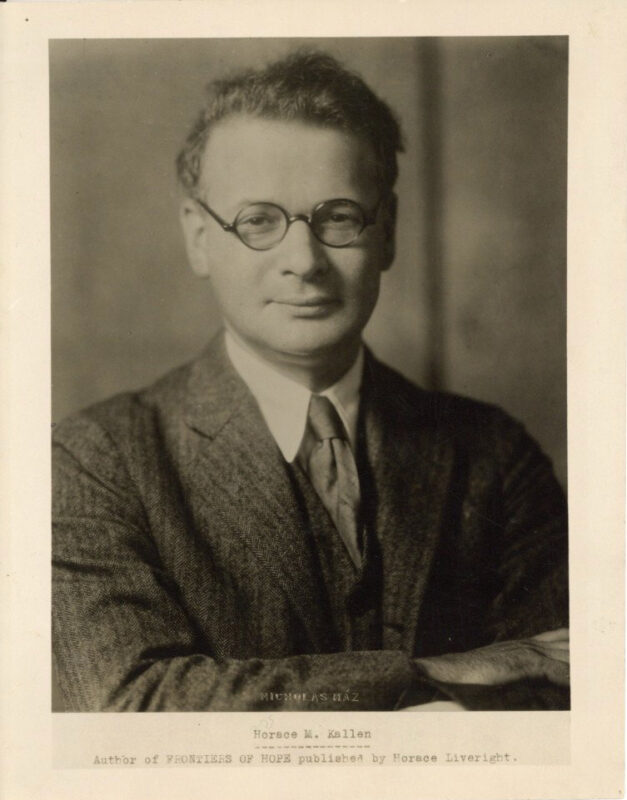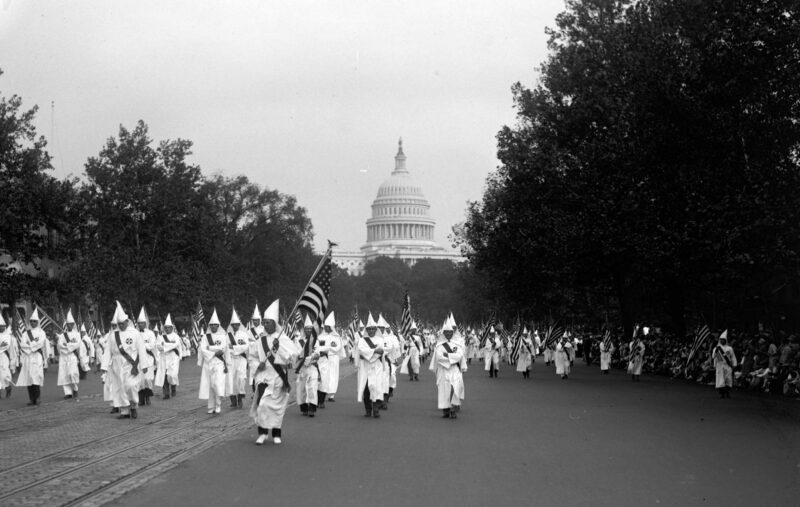Editor's Note
These remarks were originally prepared for the session “A Hundred Years of Cultural Pluralism” at the 2024 American Jewish Historical Society Biennial Scholars Conference. David Weinfeld organized the session to mark the centennial of the publication of Horace M. Kallen’s Culture and Democracy in the United States in 1924.
In 1924 the philosopher Horace M. Kallen published a collection of essays under the title Culture and Democracy in the United States. It was here that Kallen first introduced the name cultural pluralism for the ideas he had previously put forward in his well-known 1915 essay “Democracy Versus the Melting-Pot.” All the essays in the book were written and most of them previously published between 1914 and 1924, a decade that Kallen described as “one of the most critical ten-year periods that the Republic has ever passed through.”[1] In describing the decade as a protracted crisis catalyzed by the First World War, Kallen meant crisis in the literal sense of a moment of decision between “old things” struggling “against death” and a “new pattern for the energies of the group life.”[2] The book’s postscript, subtitled “Culture and the Ku Klux Klan,” formulated the decision precisely: “The alternative before Americans is Kultur Klux Klan or Cultural Pluralism.”[3] What did these alternatives mean, and what do we make of this critical decision from our own historical vantage point a century later?
The decade from 1914 to 1924 was harrowing for American Jews like Kallen. As the historian John Higham later pointed out, “virtually the whole system of anti-Semitic discriminations,” including restrictive quota systems in education, barriers in business activity and employment, and residential discrimination, “was worked out by 1917.”[4] In addition, the national origins quotas legislation of 1921 and 1924 severely restricted Jewish immigration. Although Jews were not the only group to whom the Mother of Exiles closed the golden door, “the Jews faced a sustained agitation that singled them out from the other immigrant groups blanketed by racial nativism—an agitation that reckoned them the most dangerous force undermining the nation.”[5] The decade also saw the lynching of the Jewish factory superintendent Leo Frank in 1915, which spurred both the establishment of the Anti-Defamation League, dedicated to fighting antisemitism and other forms of bigotry, and the revival of the Ku Klux Klan, which added antisemitism to the antiblack racism of the original Klan. By the 1920s, the new Ku Klux Klan had more than four million members, Klan members served in all levels of government, and the organization wielded political power throughout the nation.[6]

Horace M. Kallen c. 1929. Courtesy of The Jacob Rader Marcus Center of the American Jewish Archives, Cincinnati, Ohio, at americanjewisharchives.org.
Kallen’s postscript described the Klan as part of a broader reaction against modernizing and liberalizing changes in America, a reaction that he suggested was also apparent in the nativism, pseudo-scientific racism, and religious fundamentalism of the decade from 1914 to 1924. (The Scopes trial would take place in 1925, a year after the publication of Kallen’s book.) The Klan’s membership, Kallen wrote, is “recruited from every class and every station in the United States that considers itself ‘native, white and Protestant.’” Fueled by status fears and anxieties, the Klan directed its “animating hatred” at every outgroup that deviated from this type.[7] He summed up its viewpoint this way: “The old values that rule the common life are in danger. Arm, arm, lest they be destroyed.”[8]
Much as the sociologist Daniel Bell would later describe the radical right of the 1960s as fighting modernity in the shadow of Communism, Kallen described the Klan as a “convulsive effort” to prevent the dissolution of the “old ways and standards of life in the United States” by modern industry, science, and democracy.[9] Also like Bell, Kallen suggested that the effort was ultimately doomed to failure. “There is a Quixotism in [the Klan],” he wrote, albeit “a sordid and degraded Quixotism, without grace, without kindness.”[10]
Kallen associated the German word Kultur with German imperialism and later with fascism. For him, it signified monism, conformity, servile oneness, and regimented unity. “To the sensibilities of the free world,” he wrote much later, “Kultur does not mean culture. It means a nineteenth- and twentieth-century representation of an exclusive racism of attitudes, thoughts and things.”[11] Following his teacher, the philosopher William James, Kallen rejected monism in favor of a pluralistic worldview. He associated cultural pluralism with democracy and federalism; it signified manyness rather than oneness, difference rather than conformity, and free communication and spontaneous orchestration among different groups of people.
With echoes of the historian Frederick Jackson Turner’s frontier thesis, Kallen argued that the spaciousness of the North American continent fostered democracy and pluralism against “the compulsions toward conformity that have periodically swept like tides over the nation.”[12] Democracy, as Kallen conceived it, “sanctions and encourages differences” and “confirms the equal right” of different people “to life, liberty, and the pursuit of happiness.”[13] True cultural growth and development is possible only under conditions of cultural pluralism, he argued, and “Cultural Pluralism is possible only in a democratic society whose institutions encourage individuality in groups, in persons, in temperaments, whose program liberates these individualities and guides them into a fellowship of freedom and cooperation.”[14] It was precisely this democracy, he believed, that was at stake in the United States in the critical decade of 1914 to 1924.

Ku Klux Klan march in Washington, DC, 1925. Source: Library of Congress (public domain).
If Kallen’s ideas strike a chord today, it is surely because our own polarized political context is in some respects analogous to his. The historian Nicole Hemmer has recently argued that Donald Trump’s right-wing, ethnonational populism arose from a transformation of American conservatism in the 1990s. A key figure in this transformation was the antisemite Pat Buchanan, who revived elements of the interwar Old Right that conservatives had abandoned during the Cold War. Rejecting “Reaganite positions on free trade, interventionism, and immigration,” the new post-Cold War conservatism embraces protectionism and economic nationalism, isolationism, and nativism.[15] Furthermore, Hemmer suggests, the lines between mainstream conservatism and the violent far right have blurred since the 1990s, as evidenced by the extremist groups that glommed onto Buchanan’s presidential campaigns in the 1990s and Trump’s campaigns since 2016.[16]
Perhaps the best illustration of these trends is the spread of the “Great Replacement” conspiracy theory. In his 2011 book Le Grand Remplacement, the French writer Renaud Camus argued that a left-wing elite is working to replace white Europeans with nonwhite immigrants from Africa and the Middle East in what he called a “genocide by substitution.” Although Camus’s “initial concept did not focus on Jews and was not antisemitic,” white supremacists who adopted the theory in the United States have blamed Jews for nonwhite immigration into this country.[17] This antisemitic modification of the theory is not incidental. As the civil rights activist Eric Ward has shown, antisemitism is the “theoretical core” and “lynchpin” of white nationalism insofar as white nationalists see Jews as a distinct (nonwhite) race and an “all-powerful cabal that uses subhuman others, including Blacks and immigrants, as pawns to destroy White nationhood.”[18] These are the ideas that inspired the chant “Jews will not replace us” at the 2017 Unite the Right rally in Charlottesville, Virginia, and the murderous assault on Pittsburgh’s Tree of Life Synagogue in 2018, which the Anti-Defamation League described as “the deadliest attack on the Jewish community in the history of the United States.”[19] Spreading beyond extremist fringe circles, the Great Replacement theory has been popularized by US congressmen, Fox News, and on social media. A poll taken in 2022 found that more than 60 percent of the Americans who voted for former president Trump agreed that “a group of people in this country are trying to replace native-born Americans with immigrants and people of color who share their political views.”[20]

Memorials to victims outside the Tree of Life synagogue. Source: Wikipedia (public domain).
Other extremist ideas have also spread from the antisemitic far right into mainstream political discourse in recent years. The use of the term “globalist” as an anti-Jewish dog-whistle received widespread attention in 2018 in connection with the resignation of Trump’s chief economic advisor Gary Cohn and the attempted bombing of the philanthropist George Soros’s home in New York. As Aryeh Tuchman from the Anti-Defamation League noted, the term is linked to “long-running conspiracy theories about Jewish populations not being loyal to the countries they live in and cooperating through secret international alliances.”[21]
It’s hard to miss the parallels between the virulent antisemitism, nativism, and racism of Kallen’s critical decade and paranoid fantasies about a “white genocide” purportedly committed by Jewish globalists in our own time. These parallels show the continuing relevance of Culture and Democracy in the United States. But these same historical analogies also raise doubt that the second Ku Klux Klan was engaged in a quixotic and losing fight against modernity. It may once have been possible to understand American history in terms of the inevitable triumph and expansion of liberalism, but we are less confident today. In saying this, I do not mean to suggest the inverse proposition that American history is the triumph of Kultur Klux Klan. Writing America with three Ks is a simplistic and foolish provocation, not a serious analysis of American history and politics. What I mean to suggest instead, following the political scientist Rogers M. Smith, is that American political culture is the ongoing product of the often conflictual interaction of multiple political traditions.[22] These traditions together comprise American political culture, without any one of them constituting it as a whole. From this perspective, the decade from 1914 to 1924 was not a critical moment of decision, at least not in any final and definitive sense, because Kultur Klux Klan and its alternatives are always available to Americans. What it means to be an American is therefore always in suspense.
Careful readers will notice that I did not specify cultural pluralism as the alternative to today’s Kultur Klux Klan. As I argue elsewhere, Kallen’s cultural pluralism was closely connected to what the historian James Loeffler calls the tradition of Jewish collectivist liberalism.[23] From the mid-nineteenth to the mid-twentieth century, Jewish collectivist liberals argued that the individual civil rights promised and partly delivered to Jews after the French Revolution were insufficient and that Jewish emancipation also required the preservation and development of Jewish group life. They “rejected the idea of the Jewish individual as the sole locus for modern politics or the disappearance of Jews as a group as the inevitable outcome of Western modernity.”[24] A public exchange in 1919 between Kallen and the philosopher Morris Cohen highlights the differences between collectivist and individualist liberalism. In contrast to the individualist liberal Cohen, who rejected the idea of group rights, Kallen insisted that “the assumptions of liberalism” must be extended “from the individual to the group.”[25]
This alternative tradition of Jewish collectivist liberalism is today largely forgotten and overlooked. As Loeffler shows, its prospects were diminished by historical developments, including the outbreak of the Second World War in 1939, which led to a negative reevaluation of minority rights, and the proclamation of the United Nations Universal Declaration of Human Rights in 1948, which “enshrined individualism as the key feature of international law.”[26] As the sociologist Nissim Mizrachi argues, individualist liberalism rests on an implicit moral grammar, according to which the social world is constituted by autonomous and equal individuals who must be liberated from the oppressive constraints of religious boundaries, national borders, and other structural relationships of power.[27] While I cannot develop the argument here, it seems to me that this individualistic moral grammar is not fully congruent with Jewish collectivist liberalism and Kallen’s cultural pluralism.
The tradition of Jewish collectivist liberalism—and cultural pluralism, which was one expression of it—are also at odds with contemporary identity politics. On the one hand, as already noted, white nationalists do not consider Jews white. They see Jews as a distinct race who manipulate the social order behind the scenes to the detriment of white people. On the other hand, recent shifts in left-wing ideologies that elevate the significance of race and postcoloniality associate Jews with whiteness, power, and privilege. Leaving aside the problem that this perspective ignores Jews of color, it also deprives Jews of the freedom to define their own identity as a people with a distinctive history and ethnic identity. Without such freedom, cultural pluralism is impossible. By submerging Jews within a larger racial category, regardless of how they self-identify, contemporary left-wing ideologies deny the meaningfulness of the ethnic and cultural distinctions that Kallen’s cultural pluralism sought to defend. Distinctive aspects of Jews as bearers of a minority culture with their own customs, language, and history can in this way be erased. In this respect, the submergence of Jews within a larger racial category is not very different from the melting-pot model that Kallen rejected. Moreover, in both white nationalism and contemporary left-wing ideologies, Jews are perceived as a powerful group rather than a vulnerable minority group in need of cultural autonomy. In short, white nationalism and contemporary progressive ideologies imagine the social world very differently, but neither leaves much room for Kallen’s cultural pluralism.
In sum, I have suggested some ways that Kallen’s historical context, and the alternatives before Americans in that context, both resemble and differ from our own. Although Kallen described the decade from 1914 to 1924 as a critical moment of decision between “old things” struggling “against death” and new alternatives, although he argued that there was a “sordid and degraded Quixotism” in the second Ku Klux Klan, what he called Kultur Klux Klan has not vanished from American political culture. To the contrary, I have suggested, we are living through the resurgence of something similar today. But I am also skeptical that cultural pluralism, in the sense that Kallen meant it, is any longer a “live option,” to use William James’s phrase. I think Kallen’s cultural pluralism was closely tied to the tradition of Jewish collectivist liberalism, and (like that wider tradition) cultural pluralism is now a largely lost and forgotten alternative in a cultural landscape dominated instead by the language of whiteness and decolonization. Could cultural pluralism be revived in some new form today? Maybe—but it would require a significant reworking of the prevailing cultural categories.
[1] Horace M. Kallen, “Postscript—Culture and the Ku Klux Klan,” in Culture and Democracy in the United States: Studies in the Group Psychology of the American Peoples (New York: Boni and Liveright, 1924), 10.
[2] Kallen, “Postscript,” 13.
[3] Kallen, “Postscript,” 43.
[4] John Higham, “Social Discrimination against Jews in America, 1830–1930,” Publications of the American Jewish Historical Society 47, no. 1 (September 1957): 19.
[5] John Higham, Strangers in the Land: Patterns of American Nativism, 1860–1925 (New Brunswick, NJ: Rutgers University Press, [1955] 1992), 277–78.
[6] David M. Chalmers, Hooded Americanism: The First Century of the Ku Klux Klan, 1865–1965 (Garden City, NY: Doubleday, 1965). Tara McAndrew, “The History of the KKK in American Politics,” JSTOR Daily (January 25, 2017), https://daily.jstor.org/history-kkk-american-politics/.
[7] Kallen, “Postscript,” 34.
[8] Kallen, “Postscript,” 13, emphasis in the original.
[9] Daniel Bell, “The Dispossessed,” in The Radical Right, ed. Daniel Bell (Garden City, NY: Doubleday, 1963), 1–38. Kallen, “Postscript,” 33–34.
[10] Kallen, “Postscript,” 39.
[11] Horace M. Kallen, Cultural Pluralism and the American Idea (Philadelphia: University of Pennsylvania Press, 1956), 40.
[12] Kallen, “Postscript,” 42–43.
[13] Horace M. Kallen, “Of Humanistic Sources of Democracy,” in The Liberal Spirit: Essays on Problems of Freedom in the Modern World (Ithaca: Cornell University Press, 1948), 175.
[14] Kallen, “Postscript,” 43.
[15] Nicole Hemmer, Partisans: The Conservative Revolutionaries Who Remade American Politics in the 1990s (New York: Basic Books, 2022), 74–75.
[16] Hemmer, Partisans, 14.
[17] Anti-Defamation League, “‘The Great Replacement’: An Explainer” (April 19, 2021), https://www.adl.org/resources/backgrounder/great-replacement-explainer.
[18] Eric K. Ward, “Skin in the Game: How Antisemitism Animates White Nationalism,” Political Research Associates (June 29, 2017), https://politicalresearch.org/2017/06/29/skin-in-the-game-how-antisemitism-animates-white-nationalism.
[19] Anti-Defamation League, “ADL Statement on Synagogue Shooting in Pittsburgh” (October 27, 2018), https://www.adl.org/resources/press-release/adl-statement-synagogue-shooting-pittsburgh.
[20] Olafimihan Oshin, “6 in 10 Trump Voters Agree with Core Tenet of Great Replacement Theory: Survey,” The Hill (May 24, 2022), https://thehill.com/homenews/state-watch/3499877-6-in-10-trump-voters-agree-with-core-tenet-of-great-replacement-theory-survey/.
[21] Eli Rosenberg, “Trump Called Gary Cohn a ‘Globalist.’ Here’s Why Some People Find That Offensive,” Washington Post (March 9, 2018), https://www.washingtonpost.com/news/the-fix/wp/2018/03/09/trump-called-gary-cohn-a-globalist-heres-why-some-people-find-that-offensive/. William K. Rashbaum, “At George Soros’s Home, Pipe Bomb Was Likely Hand-Delivered, Officials Say,” New York Times (October 23, 2018), https://www.nytimes.com/2018/10/23/nyregion/soros-caravan-explosive-bomb-home.html.
[22] Rogers M. Smith, Civic Ideals: Conflicting Visions of Citizenship in U.S. History (New Haven, CT: Yale University Press, 1997).
[23] Chad Alan Goldberg, “Horace Kallen’s Expanding Vision of Cultural Pluralism: Nationality, Race, and Democracy on the World Stage, 1918–1939,” American Jewish History (forthcoming). James Loeffler, “‘A Certain Type of Liberalism’: Minority Rights in Jewish Liberal Discourse, 1848–1948,” in Jews, Liberalism, Antisemitism: A Global History, eds. Abigail Green and Simon Levis Sullam (Cham, Switzerland: Palgrave Macmillan, 2020), 365–85.
[24] Loeffler, “‘A Certain Type of Liberalism,’” 367.
[25] Loeffler, “‘A Certain Type of Liberalism,’” 375.
[26] Loeffler, “‘A Certain Type of Liberalism,’” 369, 380.
[27] Nissim Mizrachi and Erica Weiss, “‘We Do Not Want to Assimilate!’: Rethinking the Role of Group Boundaries in Peace Initiatives between Muslims and Jews in Israel and in the West Bank,” European Journal of Cultural and Political Sociology 7, no. 2 (2020): 172–97. Nissim Mizrachi, Beyond Suspicion: The Moral Clash between Rootedness and Progressive Liberalism (Berkeley: University of California Press, 2024).

0